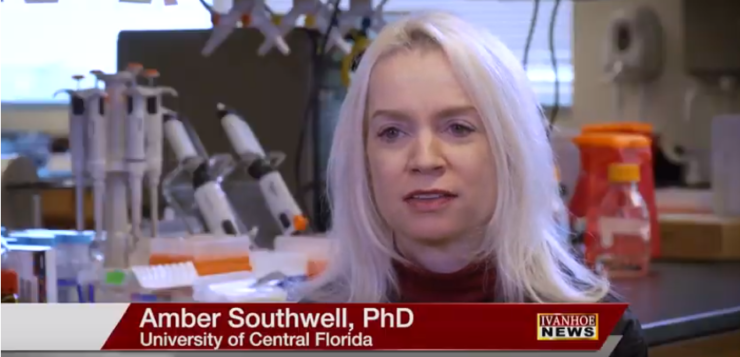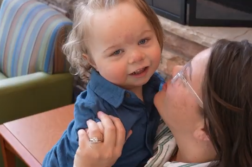Amber Southwell, PhD, an HD researcher who was awarded the HDSA HD Human Biology Project Fellowship, talks about her work with Huntington disease, and the research that’s leading her team to reducing the disease-causing protein.
Interview conducted by Ivanhoe Broadcast News in January 2019.
So tell me how did you get involved in studying the Huntington disease? How did you get involved in that?
Southwell: Do you want the long story or the short story?
Let’s try the long story. How long is the long story?
Southwell: Not that long. I come from a science legacy family, my father is a toxicologist, and my grandfather was a naval chemist. My grandmother was a physicist in a time when not very many women were physicists, and my mother’s a mathematician. So I kind of had that, growing up I was never scared of math or science, it was just what you do. When I was 16 years old, I read the book “Surely You’re Joking, Mr. Feynman!” Richard Feynman was a Nobel Prize winning physicist who was really eccentric and just a wonderful human being, he was the president of Caltech. And so I got very interested in Caltech. It seemed like a place where not only intelligence, drive and curiosity were rewarded; but also individuality and thinking differently than the herd. So I worked very hard in my undergraduate to get to a point where I could attend Caltech as a graduate student. While I was doing that, I started off in chemistry and realized that the chemistry I was really interested in was that of my own body. So I went into biochemistry. And I just went further and further down that road. When I got my biochemistry degree I had joined a molecular biology lab and was doing biology projects, and I ended up staying another year because I was enjoying that laboratory research so much. In that time, I took a neurology class. When it came to abnormal neurology, the sections on what happens to people who have particular types of brain damage and how that affects their lives, it was so fascinating to me because more than anything else, it just shows you that reality isn’t reality. Reality is what your brain allows you to perceive, what you’re capable of perceiving. And it was just fascinating. So I wanted to go into neuroscience. And when I got to Caltech and started working in neuroscience, I found that I cared very much about problems related to human health. I thought about what human health problems were really relevant for neuroscience, and it seemed to me that neurodegenerative disease was the most important thing. Medical science has dramatically increased our lifespan but not our quality of life in old age. The older our population gets, the greater proportion of people who are afflicted with debilitating neurodegenerative diseases. I actually chose to start studying Huntington disease because it is the most common genetic neurodegenerative disease. I thought that this would make it a more tractable problem. For instance, if we could tell far enough in advance who was going to get Alzheimer’s, there are things we could do to delay onset. I figured that with a genetic disorder, you can tell decades before people get sick; it’s an adult onset disorder. People are born with the mutation. You know certainly, we can find ways to delay the onset, push it back 10 or 20 years, and really improve patient quality of life. Unfortunately, Huntington’s is a much more complex pathogenesis than most neurological disorders. A lot more goes wrong. There’s not one central pathway that’s disrupted. It’s basically every pathway in the brain that’s disrupted. So finding a way to delay onset or slow progression has been a much harder problem. But by the time I realized that my logic in choosing it as the easier problem was completely wrong, I was committed. There’s a saying in the HD field that we don’t make friends, we take hostages. Once you start working in HD, it’s such a collaborative research field with an invested and educated patient population and really, really wonderful foundations. And you meet and get to know people who are sick and people who are at risk and people who are gene positive but not sick yet. Eventually you get to a point where you’re coming to work every day for those people. And nobody can convince me to start working on an easier problem, basically.
And for people that don’t know about Huntington’s disease, how does it affect people? What happens?
Southwell: HD is described as being as if somebody has schizophrenia ALS and Alzheimer’s disease simultaneously. It affects every part of a person’s life. The thing people think of first when they think of Huntington’s is chorea, which is excessive involuntary movements. Chorea is Latin for dance; it’s big involuntary dance-like movements. But not everybody has severe chorea. The symptoms also include cognitive symptoms, difficulty with executive function, eventually progressing to dementia. Then mood symptoms, which can often be some of the most debilitating for patients and in some cases, are not progressive. Anxiety and depression can affect people decades before onset of motor symptoms. OCD is common, but also psychosis can be common. And when people get close to onset, it’s not unusual for them to have a personality change, and to become more irritable. This puts a real strain on families.
Tell me about your research. What are you and your colleagues looking at?
Southwell: We’re working on ways to reduce the disease-causing protein. The mutation is in a gene called huntingtin. It makes the huntingtin protein. The reason that Huntington disease is so complex is because the huntingtin protein is so complex. It’s an enormous protein and it binds with so many partners. It’s very promiscuous within the cell; it’s involved in tons of cellular pathways. So when you get a mutation in this protein, all of those pathways go wrong. But the normal huntingtin protein, the non-mutated mutated copy, most people who have the mutation just carry one copy of it. You only need one copy to get sick, it’s very rare to have somebody with the mutation on both copies of their huntingtin gene. That would take two people who were carriers having children and, being a fairly rare disease, that doesn’t happen that frequently. The normal huntingtin protein, it does play all these really important roles in the cell. It’s a stress-response protein, it helps neurons send signals and helps regulate transcription. As in what genes are made into proteins within the cell, and which ones are not. It does a lot of really important things. So we want to maintain that normal huntingtin and its good functions, while reducing the mutant huntingtin. And we’re doing this using antisense oligonucleotides, ASOs. These are short pieces of chemically-modified DNA that go into the cell and specifically suppress particular genes. For example, in your cell you have basically the menu for your entire body. You have all of the DNA for any type of cell, for anything that your body produces, is in every cell. But not every cell needs the same components, so there’s an intermediary. In addition to the DNA there’s a molecule called RNA that’s in between. The components that are going to be made in each cell are first copied into an RNA message and that leaves the nucleus where the DNA is. The RNA is used to make a protein and then the cell uses the protein. So what ASOs do is they bind to and they recognize that RNA message. They can be very specific. In our case, we’re targeting single-base pair changes. The huntingtin gene is over 180,000 base-pairs long, it’s enormous. If you have one single base change, you would think that’s so tiny, you wouldn’t be able to target that. But ASOs are really highly specific. We’re able to target these single-base differences between the normal gene and the mutant gene. The ASO binds to that target, only the mutant RNA message, and not the normal one. When it makes this structure that’s DNA from the ASO and RNA bound together, that doesn’t normally happen in a cell. That typically only happens when a cell has been infected by some kind of pathogen so this activates the cell’s natural defenses. Then an enzyme called RNAse H, which is specifically to degrade these type of pathogenic nucleic acids, comes in and it chops up that RNA message, so that it can’t be made into a protein. And it doesn’t cut up the ASO, the ASO sticks around and is then able to destroy more and more of those RNA messages. We’ve found, through lots of screening and lots of development, we were able to identify some ASO sequences and designs that very, very selectively, basically with perfect selectivity, don’t suppress the one type, the normal huntingtin gene and are very active against the mutant huntingtin gene.
And the ASOs the cells, you said that they stick around. Is there a certain time limit or expiration to them?
Southwell: Yeah, they do eventually get degraded by the cell, but not in the same process that destroys the mutant huntingtin message. They have about a 100-day half-life in the brain. If an ASO is stronger, if less of the ASO is required to actually achieve suppression, we’ve found that the duration of action can be much longer. Because they reach a max suppression-level, a level beyond which they’re not going to reduce their target any more. But then as the molecule is degraded over time, with a very, very strong molecule you need less of it to actually work, so its effect lasts longer. We’ve done time course studies and found some of ours with about 46 weeks of action, which is much longer than the half-life.
So what indications does your findings have for medicine? The medical field?
Southwell: One of the other things that’s great about ASOs, one of the reasons that I chose to work with them, is that they have a really good track record of clinical success. The first ASO drug was approved in 1998 by the FDA, that was for external use. But now in 2017, we had the first CNS, the first ASO drug for the brain and spinal cord that was approved by the FDA. That was for spinal muscular atrophy; an incredibly devastating disease, where children don’t develop, and it’s fatal. This was an amazing thing, really, because the clinical trial for this was halted for efficacy, which is very unusual. The drug was working so well, the babies were surviving so well that the FDA, everybody said OK, we have to stop because there’s a group that’s getting placebo. We have to stop the trial, because it works so well we need to get all the babies on this drug. So there’s a proven track record that you can put these types of molecules into the brain and they can be effective drugs in humans and well tolerated. The same company that has this SMA drug, the one that I collaborated with as well, Ionis Pharmaceuticals, they recently completed the first huntingtin-lowering clinical trial. This was an ASO that targets both the normal and the mutant huntingtin. They did a dose-escalation safety trial and they didn’t see adverse events related to the drug. It is an epidural injection; so people got headaches and things that can normally happen with spinal injection. There’s excellent clinical accessibility for these molecules. Now that we’ve shown this in mice and in neurons in a dish; that we’re able to selectively suppress just the mutant huntingtin and that we’re able to either prevent the onset of symptoms or actually restore normal functions if we start treatment after symptoms have begun, this gives a really nice pathway to lead to a human clinical trial.
Do you have a timeframe on the next steps, or when you think that human trials could start?
Southwell: There are a lot of points of failure. Mice aren’t people, neither are neurons in a dish. There are many, many steps in between and at any point something could fail. This is an incredibly exciting time. It is the first time we’ve been able to actually prevent disease, or completely cure a mouse. We don’t like to use the word cure because even if someone has no symptoms, they still have the genetic mutation. Sort of like an asthmatic. For instance, I have asthma, I use a preventative drug, I haven’t had an asthma attack in maybe 10 years, but I still have asthma. I’m not cured, but I have no symptoms. That’s kind of the goal for HD. We’ve been able to do that in mice, and that’s amazing. When I first started working in this field, I’d see people’s preclinical data, and they’d make this tiny improvement in the motor function of mice. Everyone would get really excited, and they’d start a clinical trial. And I just thought, why? But then, one of my neurologist friends actually told to me once that, at that time, the best treatment he had for his patients was the placebo effect. Therefor he wanted them in a clinical trial, which kind of floored me. But it’s very exciting. We can now treat an animal the way that we eventually want to treat people. Yet, there’s so much to do in between. Because it’s safe and effective in mice, they’re different. People still have to do safety in large animals; they have to do distribution studies in larger animals. Then there are many different levels of clinical trial. The first thing to do is a safety trial. It’s what was just completed for the ASO that reduces both the normal and the mutant proteins. It’s not related at all to symptoms, it’s just to see if it’s tolerated. So it’s a short trial, it’s not long enough to look at effects on symptoms; it doesn’t have enough people in it. There’s a lot of variability in symptom severity in which types of symptoms people have. There are many, many steps and things could go back to the drawing board at any time. Although we’re pretty confident, I can’t put a number on it.
What surprised you most about the findings?
Southwell: Two things, both in terms of cognitive performance. First, in learning and memory in the mice. When we treated before symptoms, we were looking at several different ASOs. One that was very long-acting and only reduced the mutant huntingtin, and one that was a very short-acting and only reduced the mutant huntingtin. When we gave these before symptoms, early on,at six weeks of age for a test that we performed at nine months of age, for the very long-acting drug, there was still some mutant huntingtin suppression, and there was no learning and memory problems, which I would expect that. For the very short-acting drug, for which the mutant huntingtin levels had returned to normal months before we did the test, there was still no learning and memory problems. I didn’t expect that. I didn’t expect the benefit to cognitive function to so far outlast the period of the drug’s action. There had been some previous evidence that, for motor performance, there was an extended period of benefit after the period of drug action. But I had no reason to expect that it would be the same with cognitive function, that it would be that lasting and so complete. It wasn’t like the animals were improved; the animals were completely normal in this performance. So that was surprising. The other thing was in the reversal. When we took animals that were cognitively impaired that had lost the ability to learn spatially, which direction is what, and to recognize objects and we treated them, it didn’t just improve them. Again, it brought them back to completely normal function. So this was unexpected, but very encouraging.
And what impact do you think this research has on someone like Danny?
Southwell: Well, one of the reasons I thought it would be so much easier to study a genetic disease is that it’s much easier, you would think, to keep brain cells alive and healthy than it would be to teach the brain to function without them. People like Danny, who have already started experiencing symptoms, have already lost brain cells. Not as much as somebody who is in the later stages of the disease, but they’ve already lost brain cells, and there’s a lot that are malfunctioning. What we saw with the mice suggests that somebody who already has this loss of cells, this could not just halt the progression of the disease, it could bring them back to a greater functional state, which that’s the dream.
What makes your research different than other research that are studying the same disease?
Southwell: HD is an enormous problem, there are a lot of people working on it, and there’s enough room for everybody’s work. One of the things that’s great about the field is that we are really collaborative, we talk to each other. If two people were to chat at a meeting and find out they’re working in something very similar, rather than not saying anything and going home and trying to get lots done, they would kind of discuss it and carve out pieces, I’ll do this you do that, and maybe we can help each other because you can test things that I can’t test, and I can test things you can’t. We all work pretty hard to make sure that we’re doing complementary work. There was another group that developed ASOs that suppressed both the normal and the mutant huntingtin. There was a group that was looking into targeting the actual mutation to try to suppress only the mutant huntingtin. That turned out to be pretty complicated, because the HD mutation, it’s actually the expansion of a normal genetic piece. We have in the beginning of our huntingtin gene; everybody has what’s called the CAG track. It’s just the DNA letters CAG repeated over and over again. CAG, CAG, CAG. In normal individuals, this is typically in the teens, but can be as big as 26. In people with HD, it’s 36 or higher. The longer it is usually correlates with symptoms becoming apparent earlier. Because every huntingtin gene has a CAG repeat in it, targeting that longer CAG repeat with a gene-silencing reagent is complicated. Because that reagent can also recognize the normal huntingtin gene and in some cases other genes in the genome that also have this CAG repeat. So we were working on targeting single-base changes that are different between the two genes. There are lots of different groups, all sharing unpublished data with one another, all are working on different aspects. Obviously I think my approach is the best one, but this is a really, really big problem and we need to try everything.
Would it be correct to say that you were among the first to use the ASO, in seeing the actual prevention of the disease and the reversal of it?
Southwell: The group that developed the non-selective ASO, the one that’s gone to a safety trial, they showed with motor symptoms that they could get improvement. It wasn’t a full restoration to normal performance, but they got improvement in motor performance when they went in after the animals were already experiencing symptoms and this lasted much longer than the drug itself did. So they, in motor, were able to show that. Our work was the first to look at cognitive function. One of the things about ASOs in people is that these are drugs we put into the cerebrospinal fluid, so this is a fluid that bathes the brain. A mouse has a much smaller brain, so when we do this with mice, it gets everywhere in the brain. The same amount, it’s really uniform. Mice don’t have as complex a brain as people do and it’s certainly a lot smaller. When we do this with larger animals, with people, there’s more drug in the more superficial areas of the brain, areas that are in more contact with the CSF and less in the deeper structures of the brain. So there were some concerns about using these in people, when the deeper structures of the brain are the ones that really mediate motor performance and movement. We were able to show, in this study, that the areas of the brain that are reached very well by ASOs and mediate these symptoms that are most disruptive to a patient’s quality of life, the mood symptoms and cognitive symptoms, are preventable and reversible with this type of treatment. I think that has a big impact on potential therapy for patients.
Is there anything else that you would like to add about the disease or research?
Southwell: I would have to open an entire new can of worms, I think. I would say that I think anything that we can do to raise awareness is really important because this is a genetic disorder. If you don’t have it in your family or aren’t closely involved with a family that has it, people don’t really know about it. I mean, there was a character on “House” with Huntington’s and I think there was an HD patient on “Grey’s Anatomy” once, so it’s coming a little bit more out of the closet, but it was swept under the rug, not talked about, hidden, for a really long time. Now that people are finally starting to talk about it more and stop hiding it, we’re finding out that it’s a lot more common than was originally thought. There was a study that came out of my lab in Vancouver, where I started this work, that showed one in 400 people carry a gene where they could potentially develop symptoms. It’s unlikely, but it’s repeat length between 36 and 39. These people typically won’t develop symptoms, but they can. And they can certainly pass the disease to their children. So if this is something that is important for one in 400 people, we need to be thinking about it more. We need to be talking about it more.
END OF INTERVIEW
This information is intended for additional research purposes only. It is not to be used as a prescription or advice from Ivanhoe Broadcast News, Inc. or any medical professional interviewed. Ivanhoe Broadcast News, Inc. assumes no responsibility for the depth or accuracy of physician statements. Procedures or medicines apply to different people and medical factors; always consult your physician on medical matters.
If you would like more information, please contact:
Jonathan Gabriel, Media Relations
Sign up for a free weekly e-mail on Medical Breakthroughs called First to Know by clicking here





